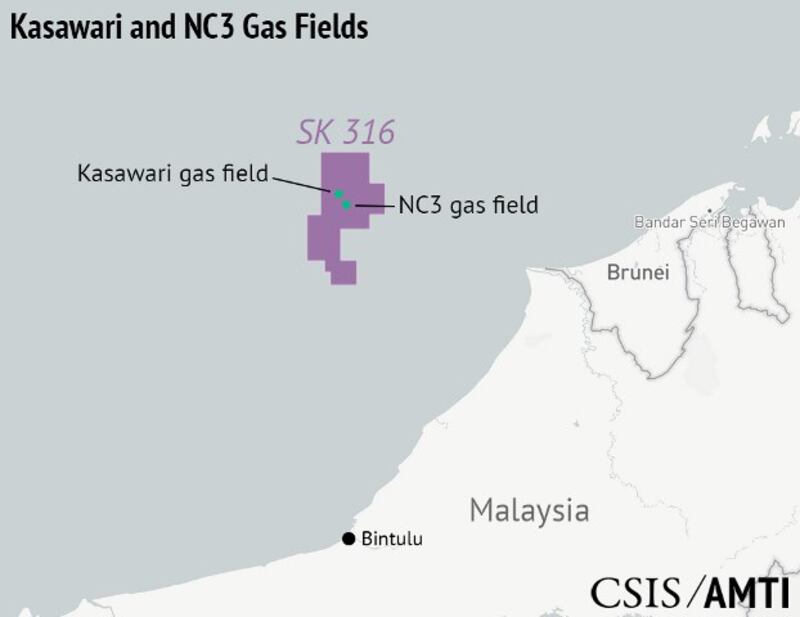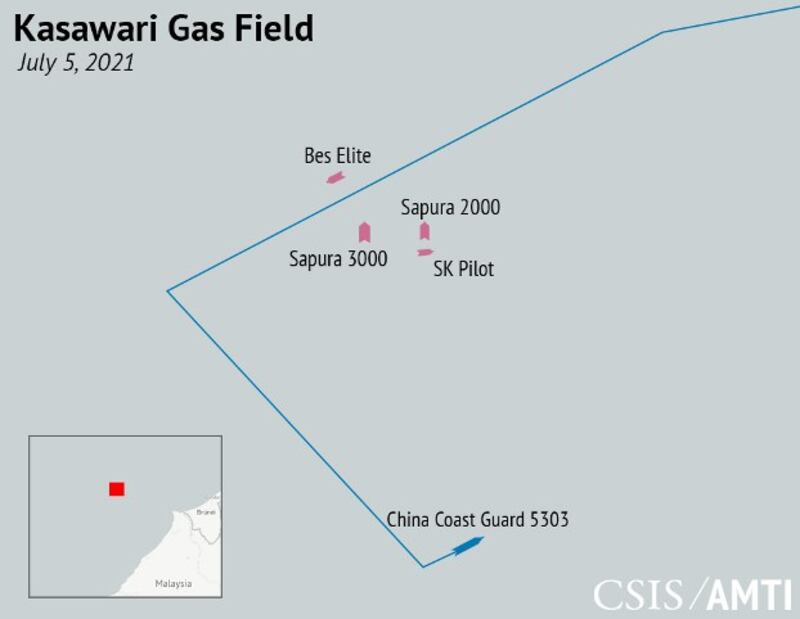Chinese coast guard ships since early June have been putting pressure on and harassing new Malaysian oil and gas projects in the South China Sea off Sarawak state on Borneo Island, a U.S.-based think-tank said in a report released this week.
Malaysian state-run oil company Petronas, which runs such off-shore operations, meanwhile announced on Wednesday that it signed a 10-year, U.S. $7 billion deal to provide liquid natural gas to a subsidiary of the China National Offshore Oil Corp.
That same day, the Asia Maritime Transparency Initiative issued a report alleging that ships from the China Coast Guard (CCG) have been "contesting" new Malaysian oil and gas development in waters off the coast of Sarawak.
“This is at least the third time since last spring that the CCG has harassed Malaysian energy exploration,” AMTI, a subsidiary of the Washington-based Center for Strategic and International Studies (CSIS), said in the report titled “Contest at Kasawari: Another Malaysian Gas Project Faces Pressure.”
“It demonstrates again Beijing’s persistence in challenging its neighbors’ oil and gas activities within their own exclusive economic zones. And the air patrol, which was likely not a coincidence, suggests Beijing’s willingness to engage in parallel escalation to pressure other claimants to back down,” the report said.
Greg Poling, senior fellow for Southeast Asia at CSIS, said he expected Malaysia’s government was taking action to protect Malaysian rights in the South China Sea. Beijing claims nearly all of the waterway as its own.
“They do it out of the public eye,” he told BenarNews, an RFA-affiliated online news service.
China and Malaysia are among six Asian countries that have contending territorial claims in the South China Sea. Beijing claims nearly all of the waterway as its own.
In a news release announcing the new deal, Petronas said it was building upon its more than decade-long relations with the state-owned Chinese corporation.
“The deal also further strengthens the ongoing relationship established since 2006 and reflects Petronas’ commitment in supporting the endeavor of CNOOC and its associated companies to meet the fast-growing demand for cleaner energy and support China’s national aspiration of peak emissions and carbon neutrality,” the release said.
The Petronas news release said the agreement calls for LNG Canada to supply product once a facility begins operation by the “middle of this decade.”
An LNG Canada spokesman said it did not comment on joint ventures.
LNG Canada is a joint venture involving Royal Dutch Shell plc, through its affiliate Shell Canada Energy, Petronas through its wholly owned entity North Montney LNG Limited Partnership, PetroChina Co. Limited through its subsidiary PetroChina Canada Ltd. and Japanese and Korean companies. It is building a liquefied natural gas export facility in Kitimat, British Columbia, Canada.

AMTI said tensions between Malaysia and China revolve around the development in the Kasawari gas field, about 4.3 nautical miles (8 km) from another Malaysian gas field, NC3, which came online in 2016.
The Malaysian government alerted mariners in advance of Petronas transporting materials on May 19 to 24 to be used to construct a wellhead platform at the site. AMTI said the alert also tipped China to the project.
The report said 16 Chinese military aircraft “flying in tactical formation,” approached within 60 nautical miles (111 km) of the Sarawak coast on June 1, leading Malaysia to scramble fighter jets.
BenarNews reported that the incident occurred on May 31 and was made public the next day.
After that incident, Malaysia’s government summoned the Chinese ambassador and vowed to launch a diplomatic protest. However on Thursday, it remained unclear what action Kuala Lumpur has since taken on the reported intrusion by Chinese air-force planes.
On June 2, a Chinese Foreign Ministry spokesman responded to a question about the incident.
“To my knowledge, it was a routine training conducted by China’s air force over waters to the south of Nansha Islands. It doesn’t target any country,” spokesman Wang Wenbin said during a daily press briefing then.
“During the training, China’s air force strictly complied with international law and didn’t enter the air space of any other country. The Chinese side has communicated with the Malaysian side over this,” he said.
Since then, Chinese ships have remained in the region, AMTI reported.
“CCG vessels regularly operate around nearby Luconia Shoals, staying there for months and often making passes by Malaysian offshore energy operations,” the report said.
Collin Koh, a research fellow at the S. Rajaratnam School of International Studies in Singapore, said Beijing’s actions are not new.
“The Chinese have been exerting such pressure on Malaysia through visible displays of its coast guard and at times, military capability. The use of the coast guard in this instance is somewhat expected, though for the most part these vessels tend to keep a respectable safe distance from the Malaysian-chartered platforms,” Koh told BenarNews.
“So far, based on my understanding, the Chinese have yet to actively interfere with activities such as blocking the passages of offshore support vessels, or attempted boarding and seizure for example,” he said.
Meanwhile, Ramli Dollah, a regional security analyst and professor at the University of Malaysia Sabah, said he expected Chinese ships to continue to harass their Malaysian counterparts.
“As we all know, China claims the entire South China Sea islands and their adjacent waters. Therefore the presence of China in this area is an imminent threat to Malaysia sovereignty,” he told BenarNews.
“The intrusion by 16 Chinese military aircraft over the disputed area in the South China Sea shows that these incidents will continue in the future.”
Ramli said Malaysia must develop its military capabilities even as it attempts diplomacy with China.
“There are also other options for Malaysia, particularly in establishing good relations and cooperation with other powers, especially the United States and those who have interest in South China Sea such as Japan and Australia,” he said.

Chinese ship spotted
As of the time of the report’s publication, a China Coast Guard ship remained at Kasawari along with two Malaysian barges, Sapura 2000 and Sapura 3000, used to construct the wellhead, AMTI said, noting it had not observed Malaysian military or law enforcement activities at the site.
“While the current tensions are likely to subside once installation of the wellhead is complete, a second phase of work at Kasawari slated for 2022 suggests that friction between Chinese law enforcement and Malaysian offshore energy operations off Sarawak is almost guaranteed to continue,” the report concluded.
Reported by BenarNews, an RFA-affiliated online news service.
